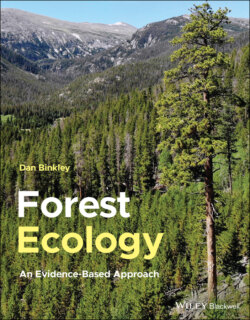Читать книгу Forest Ecology - Dan Binkley - Страница 33
Chemical and Biological Reactions Go Faster with Increasing Temperature
ОглавлениеExtreme temperatures tend to stop biological processes. Little biological activity occurs below the freezing point of water, and at very high temperatures organs fail and organisms die. Between these extremes, most biological processes respond strongly to temperature, often changing by a factor of two or more for a 10 °C change in temperature (Figure 2.4). Chemical reactions may follow a simple trend, but the response of biological processes derives from a suite of interacting factors. Some biological reactions such as respiration (the oxidation of carbon compounds to release energy and CO2) may show an exponential temperature trend, as the effect of temperature on breakdown of carbon compounds is similar to simple chemical reactions.
The temperature effect on more complex biochemical reaction rates includes any effects on the breakdown and regeneration rates of enzymes and other proteins. Biological reactions also change as temperatures affect the supplies of reactants. Higher temperatures lead to greater evaporative stresses, which reduce the supply rate of carbon dioxide flowing into leaves. The products of reactions can suppress rates of further reaction if they accumulate in cells, which can be a problem at high temperatures. Rates of photosynthesis do not increase with a simple exponential trend like rates of respiration (Figure 2.3). The temperature effect on rates of photosynthesis might have a humped shape, reflecting the balance between carbon gains and losses in leaves, as photosynthesis declines in response to rising photorespiration (the diversion of energy to producing water rather than sugar).
The temperature of an object, such as a tree leaf, represents the thermal energy contained within the object. Thermal energy is the kinetic energy of molecules; the molecules of nitrogen in a volume of air move at velocities of about 450 to 500 m per second. A molecule of nitrogen might move about 100 nm before colliding with another air molecule, which translates into billions of collisions for each molecule each second. Molecules move faster as temperatures rise, leading to more collisions and exchanges of energy that we measure as temperature. Molecules are packed more densely in liquids and solids, leading to higher rate of collisions (and transfers of heat).
FIGURE 2.4 Rates of chemical processes increase with increasing temperature, as reflected in the rising curve for respiration of trees in a rainforest in Costa Rica
(Source: Based on Cavaleri et al. 2010).
The rate of total (gross) photosynthesis by fully illuminated leaves in a rainforest in Panama also rises with temperature to an optimum near 30 °C, and then declines
(Source: Based on Slot and Winter 2017).
The two graphs present the same data, with the upper graph focusing primarily on how each process responds to temperature, while the lower graph uses a single Y axis to give show how much larger photosynthesis is relative to respiration (across the temperature gradient).
